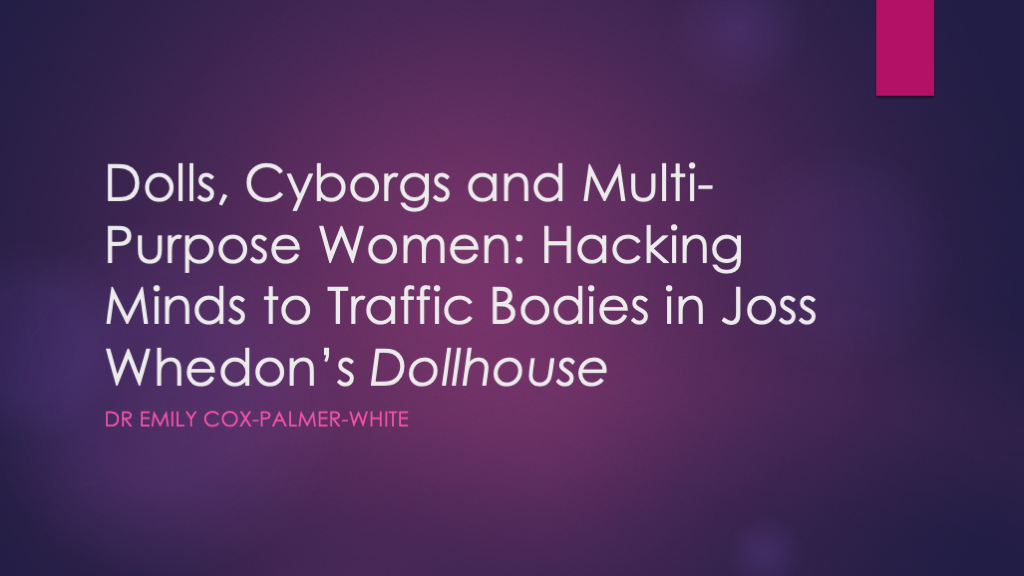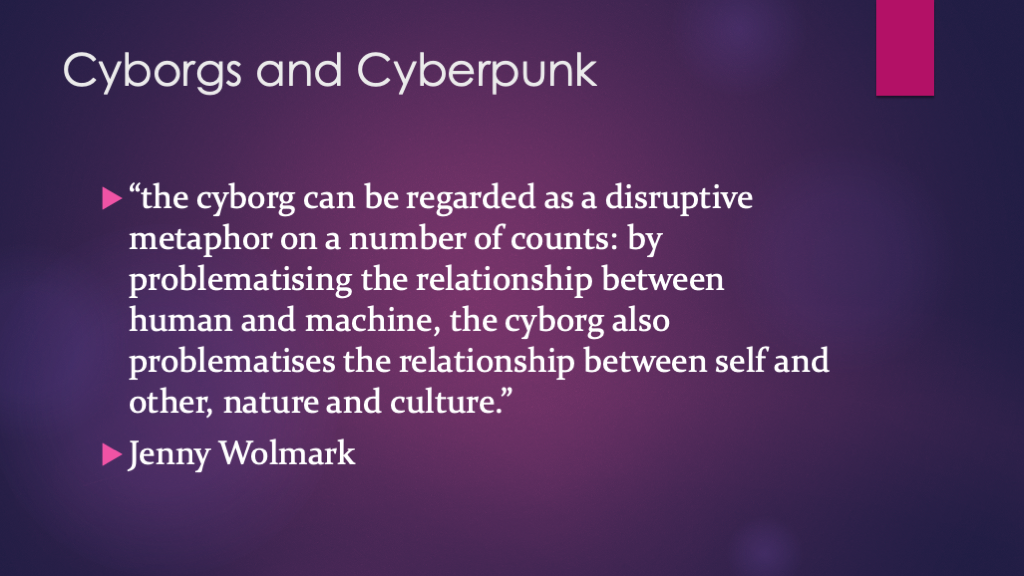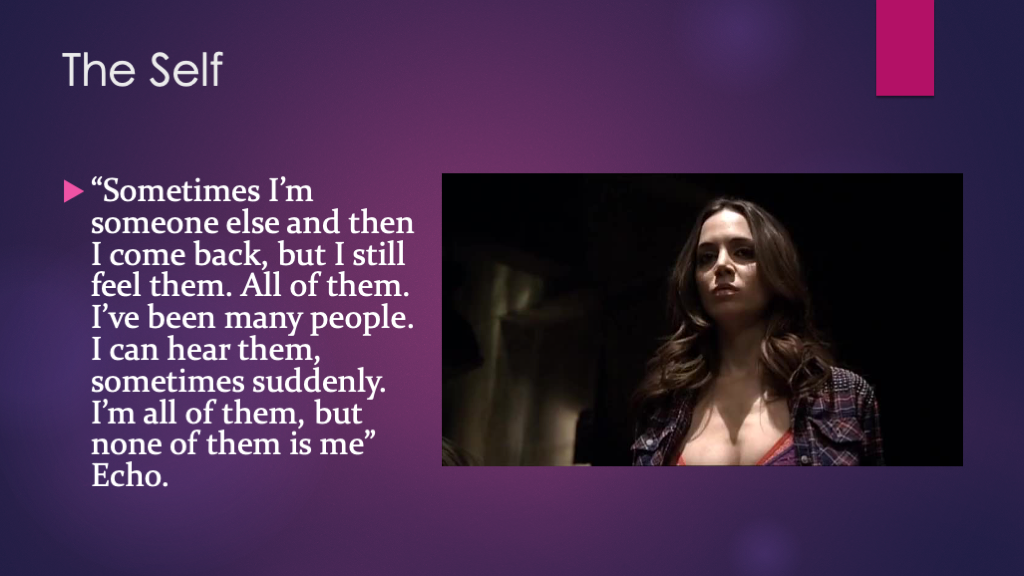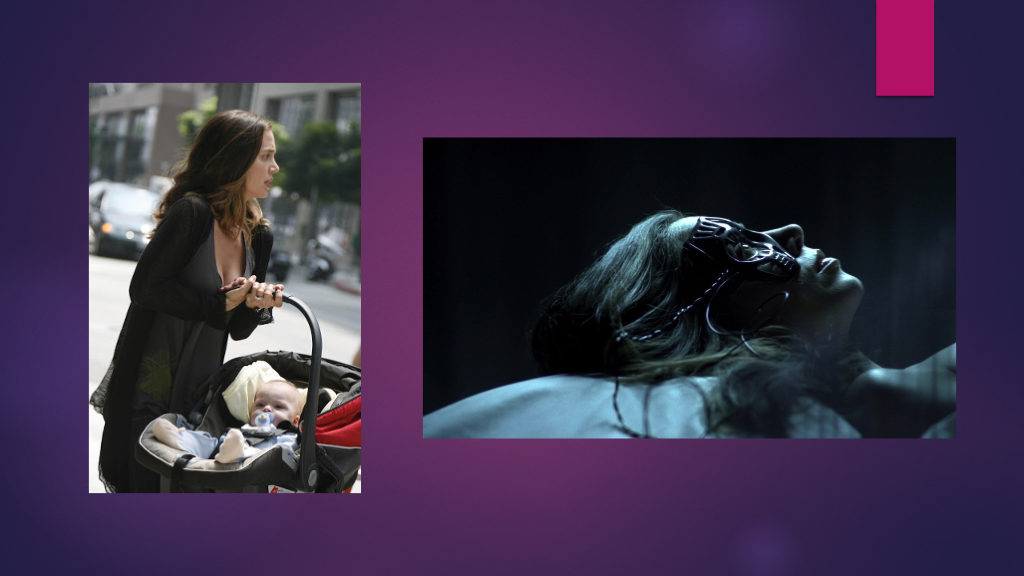Dolls, Cyborgs and Multi-Purpose Women: Hacking Minds to Traffick Bodies in Joss Whedon’s Dollhouse


Cyberpunk fiction has been interpreted by some as a masculine fantasy of the pure mind escaping the limitations of the body. Carlen Lavign argues that, contrastingly, ‘Cyberpunk written by women preserves ambiguous attitudes toward new technologies, but also comes down more firmly on the side of “actuality” (embodiment) versus “virtual reality”’[1]. This apparent gender divide within cyberpunk fiction, though contestable, highlights how the mind/body split is traditionally mapped onto male minds and female bodies. However, Donna Haraway famously argued in her Cyborg Manifesto that the cyborg figure has come to represent our current, technologically mediated historical moment. In a time when the stability of the category of human is constantly being challenged by technology and its proximity with human bodies, other forms of identity are similarly losing their integrity. As Jenny Wolmark argues: “the cyborg can be regarded as a disruptive metaphor on a number of counts: by problematising the relationship between human and machine, the cyborg also problematises the relationship between self and other, nature and culture.”[2] Haraway’s feminist cyborg figure of technologically mediated plurality challenges the traditional dichotomy of woman/body vs man/mind[3] as well as the associations of women with biology and men with technological abstraction. In answer to the virtual worlds of more traditionally masculine cyberpunk fiction which often shunned the significance of bodily identity and experience, feminist cyberpunk authors are often seen as utilising the possibilities of the cyborg entity to imagine new kinds of identities which embrace embodiment as well as virtual experience – for example Pat Cadigan, Marge Piercy and Lyda Morehouse and Melissa Scott.

Joss Whedon’s TV series, Dollhouse (2009), though it cannot be described as an explicitly feminist work, is a fascinating example of mainstream television engaging deeply with the complex themes which emerged from cyberpunk’s 90s golden age; the show engaged with the complex themes explored by feminist science fiction, such as gender and autonomy. Crucially, the show problematises the utopian promise of Haraway’s cyborg and of cyberpunk fiction by depicting a world where bodies – usually bodies belonging to women – are exploited through minds[4]. In the TV series, a malign corporation known as Rossum conducts clandestine research in a bid to create effective immortality. Their research is financed by the pimping of ‘volunteers’ whose minds are wiped clean of their original personalities so that they can be imprinted with new personalities desirable to paying ‘clients’. Clients pay a premium for the most high-end form of prostitution modern neuroscience can provide. The ‘volunteers’, whose minds are wiped become docile, empty-headed ‘dolls’ when not on assignments, but can have their minds manipulated to produce personalities constructed by the company which manages them, known as the Dollhouse.

By continually blurring the boundaries between mind and body, the show challenges the cyberpunk ideal of freeing the abstract mind from the flesh. While the show asserts that there is a distinction between bodily and mental existence and experience, it also frequently acknowledges that there is a juncture or overlap between mind and body which in some makes up a constitutive part of the self. The protagonist, Caroline, is coerced into becoming a doll by the Rossum corporation – Caroline signs over the use of her body for a period of five years, during which time she is rented out to wealthy customers for whatever purpose they see fit. During this time, Caroline is appropriately given the codename ‘Echo’, reflecting the multiple voices and personalities she comes to embody. The resident scientist of the Dollhouse, Topher Brink, insists that, once dolls have the personality imprinted on them for a particular assignment removed, they become a blank slate, retaining nothing of the ‘self’ they were temporarily embodying.

However, Echo starts to retain memories from her previous ‘lives’: “Sometimes I’m someone else and then I come back, but I still feel them. All of them. I’ve been many people. I can hear them, sometimes suddenly. I’m all of them, but none of them is me.” Yet, just as Echo appears to be becoming a composite of her new experiences (as other people) she retains a sense of a self that “is me” – perhaps this refers to the Caroline she was, a personality that has been removed from her and yet which she still acknowledges as in some way hers. Eventually, however, even the Caroline persona loses significance as Echo evolves, becoming a composite of her experiences through the Dollhouse’s imprinting procedures – forming a new identity that eventually allows her to destroy Rossum.
There are many ways to read the show, with its startling and nuanced explorations of subjectivity, consent, fantasy, sex-work and authenticity. However, I believe one of the most compelling aspects of the show is the way it reflects and explores the multiplicity of female exploitation and a cultural absence in the way we view female subjectivity.

Echo can be read as the ultimate meta portrayal of the female celebrity, whose persona is created for consumer consumption. The show is set in L.A.: even without the mind-altering, fantasy brothel premise, Dollhouse has an immediately, recognisably Hollywood feel of inauthenticity. Each doll has their own costume rack, much like those for performers needing to make quick changes between scenes. However, Echo is not merely playing a role or assuming a persona for the benefit of an audience, she is instead literally becoming the character which the Dollhouse and the wealthy and influential have created for her. The fourth-wall breaking aspects of the show startlingly engage with the inauthentic nature of the text’s very medium: a mainstream TV show. In episode 3 of season 1, Dollhouse addresses the theme of female media exploitation head-on when Echo is imprinted with the personality of a backup singer, designed to become the confidant and effective bodyguard to a popstar, Rayna whose life is under threat from a stalker. The popstar confesses that her heavily managed, super-star lifestyle makes her feel utterly fake and selfless – a corporate “factory girl”, as she describes it. As Echo tries to console Rayna, the irony is that Echo is in many ways a literal “factory girl”, whose personality has been coded and mechanically imprinted onto her mind. Echo, like Rayna, is the ideal fantasy woman, not because she embodies any ideal of female perfection but precisely because she constitutes a total absence of self onto which the corporate world can project the public’s fantasies. While this is figuratively true for Rayna, Echo is literally, an empty-headed, blank slate which can be moulded into whatever commodity the Dollhouse considers most lucrative.

Furthermore, through machinery, Echo’s mind is altered, placing the emphasis on the brain as the site for exploitation and this can be read as a metaphor for the ways in which women are socialised from birth to continually modify themselves to suit the needs and desires of others. Dollhouse frequently portrays the ways in which women are used, not only sexually, but to fulfil the emotional needs of others. Echo, though often acting as a glorified prostitute, also has her brain chemistry as well as her neural patterns altered in order to create any and every kind of woman: from steely negotiator with asthma, to the mother of a new born baby, complete with lactating breasts. The changes made to Echo to produce these different women go well beyond the scope of merely mental conditioning, also altering the body through the brain, reminding the viewer of the inseparable nature of mind and body – both on a physical level as well as on the level of personal experience and identity. Topher Brink explains that the steely negotiator persona was given asthma in order to bolster the character’s sense of resolve and determination in the face of difficulty – as in the case of Echo the mother, we are reminded of the way our bodies produce behaviours and attitudes which contribute to our sense of self.
The mechanical nature of the imprinting process as well as the experimental surgeries and bodily alterations performed on Echo challenge the boundary between mind and body as well as that of flesh and machine. This is particularly apparent in season 1, episode 5, where Echo’s eyes are surgically implanted with cameras so that she can spy on a cult leader and suspected arms dealer. In order to avoid suspicion, Echo is imprinted with the personality of a devout follower and made temporarily blind. In this way, Echo is continually transformed into a machine-like entity for clients’ consumption, blurring the boundaries between mental abstraction, bodily modification, and mental vs physical exploitation.
Before being absorbed into the Dollhouse, Echo was Caroline, an activist who attempted to expose Rossum’s unethical research practices. In order to ensure her silence, Caroline was coerced into signing herself over to the Dollhouse. The show then depicts a strong-willed, individual woman transformed into the Stepford Wife made flesh, whose entire purpose is literally to exist for others and whose multiplicity of self is neither a utopian feminist nor a traditionally masculine fantasy, but rather a nightmare vision of female exploitation.
While Dollhouse does not shy away from these themes of abuse or female oppression, the show also provides a powerful message of autonomy and emancipation. Echo is used and abused by a society that is complicit in Rossum’s activities. In a manner that is deeply perceptive for a pre-MeToo era TV series, the show makes clear that everyone knows the Dollhouse exists but refuses to openly confront this uncomfortable truth – this is revealed in a documentary segment of the pilot episode where members of the public are interviewed. In the show it is clear that every member of society is either oppressor – a client of the Dollhouse – or is part of a culture of silence which allows the oppression to continue.

In spite of this, Echo refuses to be confined by the limitations and exploitative practices which her name implies. In season 1, episode 2, a man who hires Echo so he may hunt her for sport taunts her by saying “prove you’re not just an Echo”. In the picture here you see Echo in her doll state repeating a phrase from her last client about determination – a phrase she should have had wiped from her memory along with all her other memories of that engagement. This line, “shoulder to the wheel”, marks the beginning of the trajectory of Echo’s character development, from blank slate and corporate tool of the patriarchy to autonomous individual. Over the show’s two seasons, Echo becomes a composite of all her experiences as different selves, and draws strength from her many experiences of exploitation; her character development transcends a narrative of victimhood so often used as a means of adding substance to female characters and instead acknowledges the multiple nature of individuality, encompassing the a multitude of different ‘selves’ which make up an individual.

Dollhouse can be read as the ultimate a cyberpunk play on Beauvoir’s claim that Woman is not born but made. It is also equally, I believe, a celebration of female power and autonomy in the face of crushing pressure to exist entirely for others.
[1] Lavign, Carlen, Cyberpunk Women, Feminism and Science Fiction. London: McFarland, 2013, 64.
[2] Wolmark, Jenny. “The Postmodern Romances of Feminist Science Fiction.” In Cybersexualities. Edited by Jenny Wolmark. (Edinburg: Edinburg University Press, 1999), 232.
[3] Haraway, Donna. Of Simians, Cyborgs and Women: The Reinvention of Nature. London: Free Association Books, 1991.
[4] Giaimo, Genie Nicole. “Memory, Brains, Narratives: The Humanities as a Testing Ground for Bioethical Scenario-Building” in Literature and Medicine. Spring: 2016, vol. 1, no. 1. – accessed online through Project Muse [Accessed 11.05.2020].
Discord Discussion
This discussion has been copied from the Discord server, names have been reduced to first name, discussion threads have been grouped and edited for better readability.